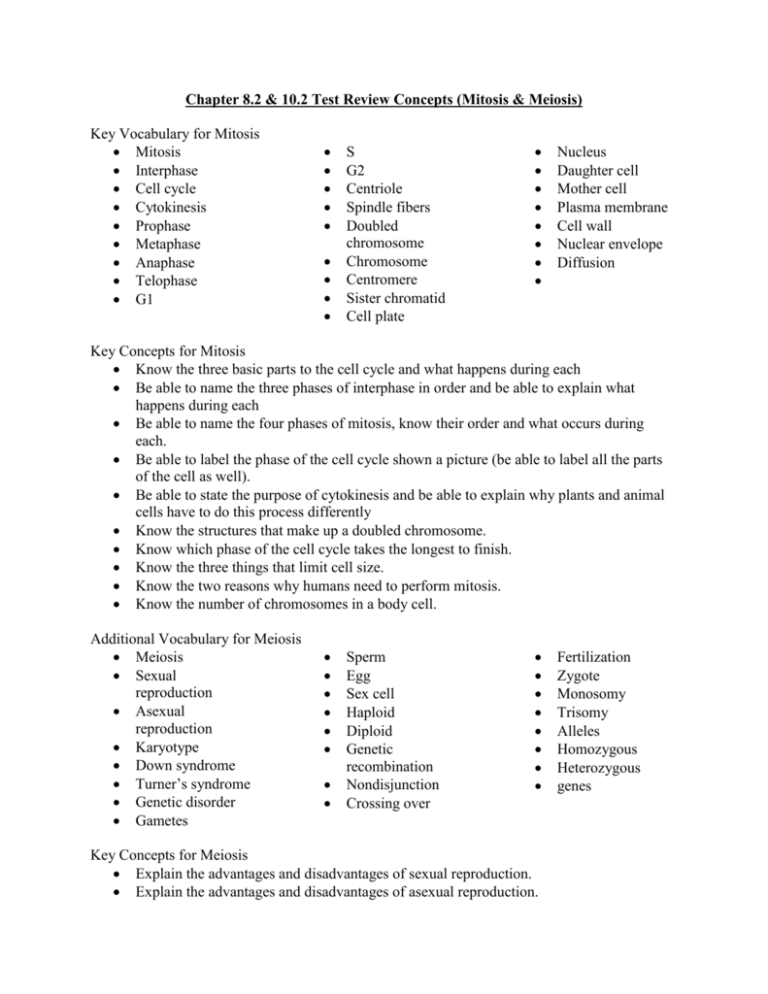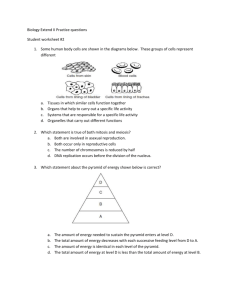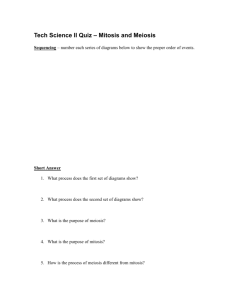File
advertisement

Chapter 8.2 & 10.2 Test Review Concepts (Mitosis & Meiosis) Key Vocabulary for Mitosis Mitosis Interphase Cell cycle Cytokinesis Prophase Metaphase Anaphase Telophase G1 S G2 Centriole Spindle fibers Doubled chromosome Chromosome Centromere Sister chromatid Cell plate Nucleus Daughter cell Mother cell Plasma membrane Cell wall Nuclear envelope Diffusion Key Concepts for Mitosis Know the three basic parts to the cell cycle and what happens during each Be able to name the three phases of interphase in order and be able to explain what happens during each Be able to name the four phases of mitosis, know their order and what occurs during each. Be able to label the phase of the cell cycle shown a picture (be able to label all the parts of the cell as well). Be able to state the purpose of cytokinesis and be able to explain why plants and animal cells have to do this process differently Know the structures that make up a doubled chromosome. Know which phase of the cell cycle takes the longest to finish. Know the three things that limit cell size. Know the two reasons why humans need to perform mitosis. Know the number of chromosomes in a body cell. Additional Vocabulary for Meiosis Meiosis Sexual reproduction Asexual reproduction Karyotype Down syndrome Turner’s syndrome Genetic disorder Gametes Sperm Egg Sex cell Haploid Diploid Genetic recombination Nondisjunction Crossing over Key Concepts for Meiosis Explain the advantages and disadvantages of sexual reproduction. Explain the advantages and disadvantages of asexual reproduction. Fertilization Zygote Monosomy Trisomy Alleles Homozygous Heterozygous genes Be able to read a karyotype and identify genetic disorders. Know the reason for the genetic disorders Turner’s syndrome, Klinefelter’s syndrome and Down syndrome. Know the normal number of chromosomes in a gamete cell. Know the two basic types of gamete cells. Be able to identify whether two chromosomes are homologous. Know whether an event is specific to mitosis, meiosis or occurs during both. Know what types of body cells are haploid and diploid. Know what the side effect of nondisjunction is. Know the purpose of crossing over and when it occurs during meiosis. Know the difference between meiosis and mitosis in terms of: o Numbers of cell divisions o Type of cells produced o Number of cells formed o Specific cell types formed o Type of reproduction that forms these cells o Purpose of process o Whether identical or unique cells are created Be able to identify homozygous and heterozygous pairs of alleles.






